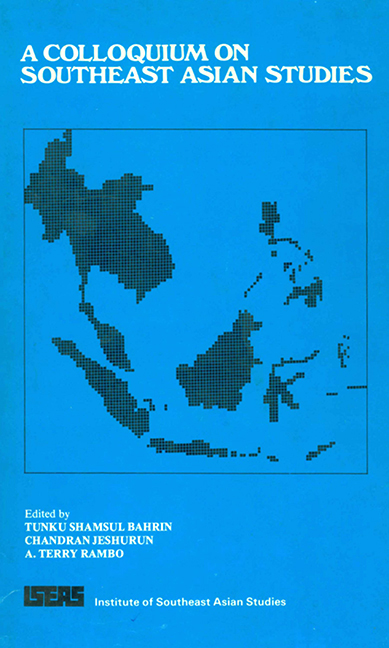Book contents
- Frontmatter
- Contents
- Foreword
- Preface
- Acknowledgements
- Introduction
- Contributors
- PART I TEACHING AND RESEARCH
- PART II ENVIRONMENT AND DEVELOPMENT
- 15 Environment and Development: The Place of Human Ecology in Southeast Asian Studies Programmes
- 16 Environment and Development in Southeast Asia: Trends, Themes and Issues
- 17 Development, Environmental Quality and the Quality of Life in Peninsular Malaysia
- 18 Environment Implications of the Mekong Development Programme
- 19 Development and Environment in Thailand
- 20 Review of Environmental Affairs in Indonesia
- 21 Research and Teaching on Human Ecology in Malaysia
- 22 Human Ecology in the Philippines: Developments in Research, Teaching and Applications
- 23 Environment Education Needs within A Southeast Asian Studies Programme
19 - Development and Environment in Thailand
from PART II - ENVIRONMENT AND DEVELOPMENT
Published online by Cambridge University Press: 21 October 2015
- Frontmatter
- Contents
- Foreword
- Preface
- Acknowledgements
- Introduction
- Contributors
- PART I TEACHING AND RESEARCH
- PART II ENVIRONMENT AND DEVELOPMENT
- 15 Environment and Development: The Place of Human Ecology in Southeast Asian Studies Programmes
- 16 Environment and Development in Southeast Asia: Trends, Themes and Issues
- 17 Development, Environmental Quality and the Quality of Life in Peninsular Malaysia
- 18 Environment Implications of the Mekong Development Programme
- 19 Development and Environment in Thailand
- 20 Review of Environmental Affairs in Indonesia
- 21 Research and Teaching on Human Ecology in Malaysia
- 22 Human Ecology in the Philippines: Developments in Research, Teaching and Applications
- 23 Environment Education Needs within A Southeast Asian Studies Programme
Summary
Thailand can be described as a market economy country with the government playing the instrumental role in setting the investment pattern. One third of the total investment of the country comes from government sources. The country itself is now in its Fourth Five-Year Development Plan (1977–81). In 1976 the per capita gross domestic product was US$380. The total population in 1977 is estimated at 43 million people with an annual growth rate of 2.6-2.8%.
During the First and Second Development Plans (1961–71), priority was given to the provision of basic economic and social infrastructural services such as the construction of highways, irrigation facilities and power systems, which contributed to the growth rate of around seven per cent per annum during the decade.
Although the overall growth rate was satisfactory, the nature of growth itself exacerbated the income disparity among various income groups and regions of the country. Hence, in the following Third Plan (1972–76) social development was introduced and integrated into the development strategy. On the social side, a three-pronged approach was adopted for the reduction of population growth rate, the improved distribution of economic and social services and the creation of more opportunities for the people. The actual rate of growth of 6.2% was achieved during the Third Plan.
Within the present Fourth Plan, the overweighing priority is given to the strengthening of national security. Area development programmes are being carried out in supporting national security objectives. Concurrently, on the development front, besides the acceleration of economic development, the main objectives are the reduction of income disparities especially through regional development and the reduction of population growth rate to 2.1% at the end of the Fourth Plan. For the first time in Thai development plans, the government adopted a definite policy concerning natural resources rehabilitation and management, with the emphasis on the four basic resources of land, water, forests and minerals.
- Type
- Chapter
- Information
- A Colloquium on Southeast Asian Studies , pp. 248 - 255Publisher: ISEAS–Yusof Ishak InstitutePrint publication year: 1981



